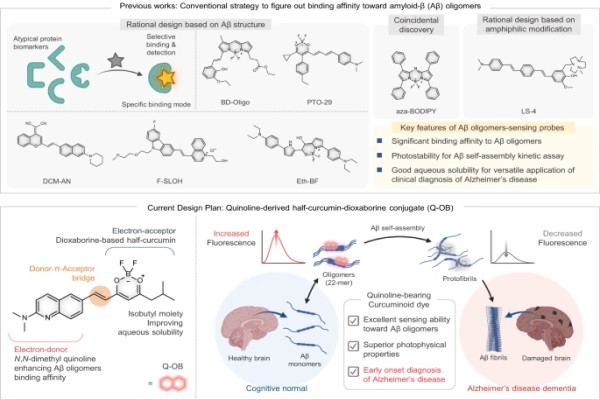A Fluorescent Probe for the Early Diagnosis of Alzheimer’s Disease Developed
A Fluorescent Probe for the Early Diagnosis of Alzheimer’s Disease Developed
A fluorescent substance that specifically binds to “amyloid-β” small molecule oligomers,
a toxic protein that causes dementia
Animal models and patient cerebrospinal fluid reveal its potential for the early diagnosis of Alzheimer’s disease

Professor YoungSoo Kim of the Department of Pharmacy, in collaboration with Professor Jong Seung Kim of the Department of Chemistry at Korea University (head of the Next Generation Molecular Theranostics Lab.) and Professor Kun-Ho Lee of the Department of Biomedical Sciences at Chosun University (head of the GARD Cohort Research Center), developed a new fluorescent probe to measure amyloid-β oligomers, a toxic protein that causes Alzheimer’s disease (AD).
AD is the most common neurodegenerative disease in the world, affecting more than 70% of dementia patients. AD, a dreaded condition that typically affects people over the age of 65, is characterized by memory and cognitive decline, and progressively worsens over time, eventually leading to death.
Although the cause of AD is not yet fully revealed, a toxic protein called “amyloid-β” (Aβ) is known to accumulate in the brain, causing neuroinflammation and the death of brain cells. Aβ begins to build up 20 years before the onset of symptoms, and early detection and removal is considered a promising treatment for AD.
To realize early prediction and preventive treatment for AD, Aβ deposits in the brain must be detected in the early stages of the disease when symptoms are not present or apparent. However, currently, the only technology available to measure Aβ deposits in the brain is positron emission tomography (PET) that is difficult to apply on a large scale owing to significant cost and time. Therefore, early prediction and prevention of AD are not feasible until the development of low-cost, universal technology that enables large-scale, rapid testing of people over the age of 60 who are at high risk of AD.
To overcome these practical limitations, Professor YoungSoo Kim and his team focused their research efforts on developing a universal predictive diagnostic technology for AD using a substance that binds directly to Aβ oligomers in the brain and emits fluorescence. The team administered the developed compound to an AD-induced mouse model and identified Aβ accumulation in the brain by fluorescence. Furthermore, this could accurately measure the concentration of Aβ oligomers in the cerebrospinal fluid of AD patients.
The study findings are expected to lead to an early diagnosis of AD by identifying the pathogenic protein early in the disease through binding to Aβ small molecule oligomers, paving the way for early prediction and preemptive treatment of AD.
This study was funded by the Ministry of Science and ICT through the Mid-Career Researcher Support Project, Leader Researcher Support Project, and Korea Brain Research Institute West-South Cooperation Project, and the results were published on February 2 in the prestigious international journal of “Nature Communications” (IF 16.6). Kyeonghwan Kim, an integrated master’s and doctoral student at Yonsei University, and Jusung An, a doctoral student at Korea University, conducted the study as the first authors, with Professor YoungSoo Kim and Professor Jong Seung Kim of Korea University and Professor Kun Ho Lee of Chosun University as corresponding authors.
Find out more:
Title of original article: Early onset diagnosis in Alzheimer’s disease patients via amyloid-β oligomers-sensing probe in cerebrospinal fluid
DOI: https://doi.org/10.1038/s41467-024-44818-x
Journal: Nature Communications
Contact corresponding author: Prof. YoungSoo Kim (y.kim@yonsei.ac.kr)
Recommended Articles
Professor Myeong Min Lee
A QUIRKY twist of fate: understanding epidermis cell differentiation in plants
Professor Jihyun F. Kim
Microbial Mercenaries for Plant Disease Resistance Ungrounded